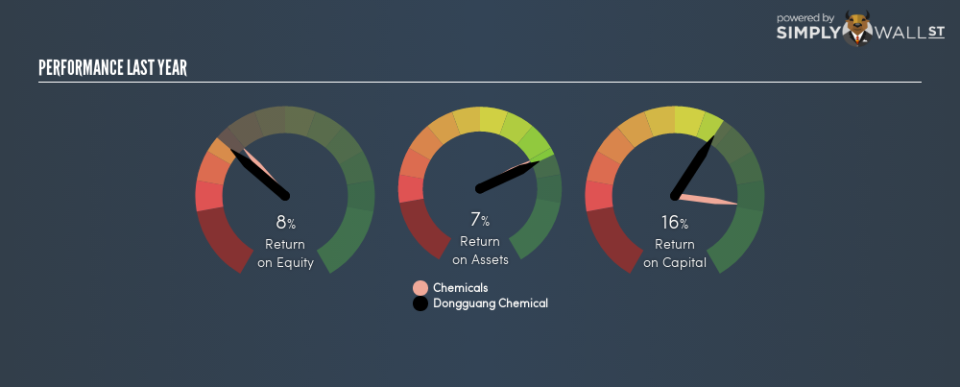Should You Like Dongguang Chemical Limited’s (HKG:1702) High Return On Capital Employed?

Today we’ll look at Dongguang Chemical Limited (HKG:1702) and reflect on its potential as an investment. Specifically, we’re going to calculate its Return On Capital Employed (ROCE), in the hopes of getting some insight into the business.
Firstly, we’ll go over how we calculate ROCE. Second, we’ll look at its ROCE compared to similar companies. Last but not least, we’ll look at what impact its current liabilities have on its ROCE.
Return On Capital Employed (ROCE): What is it?
ROCE is a measure of a company’s yearly pre-tax profit (its return), relative to the capital employed in the business. In general, businesses with a higher ROCE are usually better quality. Overall, it is a valuable metric that has its flaws. Author Edwin Whiting says to be careful when comparing the ROCE of different businesses, since ‘No two businesses are exactly alike.’
So, How Do We Calculate ROCE?
Analysts use this formula to calculate return on capital employed:
Return on Capital Employed = Earnings Before Interest and Tax (EBIT) ÷ (Total Assets – Current Liabilities)
Or for Dongguang Chemical:
0.16 = CN¥136m ÷ (CN¥2.0b – CN¥830m) (Based on the trailing twelve months to June 2018.)
Therefore, Dongguang Chemical has an ROCE of 16%.
Check out our latest analysis for Dongguang Chemical
Want to help shape the future of investing tools and platforms? Take the survey and be part of one of the most advanced studies of stock market investors to date.
Is Dongguang Chemical’s ROCE Good?
One way to assess ROCE is to compare similar companies. Using our data, we find that Dongguang Chemical’s ROCE is meaningfully better than the 11% average in the Chemicals industry. I think that’s good to see, since it implies the company is better than other companies at making the most of its capital. Separate from Dongguang Chemical’s performance relative to its industry, its ROCE in absolute terms looks satisfactory, and it may be worth researching in more depth.
As we can see, Dongguang Chemical currently has an ROCE of 16%, less than the 24% it reported 3 years ago. So investors might consider if it has had issues recently.
When considering this metric, keep in mind that it is backwards looking, and not necessarily predictive. Companies in cyclical industries can be difficult to understand using ROCE, as returns typically look high during boom times, and low during busts. This is because ROCE only looks at one year, instead of considering returns across a whole cycle. You can check if Dongguang Chemical has cyclical profits by looking at this free graph of past earnings, revenue and cash flow.
How Dongguang Chemical’s Current Liabilities Impact Its ROCE
Current liabilities are short term bills and invoices that need to be paid in 12 months or less. Due to the way the ROCE equation works, having large bills due in the near term can make it look as though a company has less capital employed, and thus a higher ROCE than usual. To counter this, investors can check if a company has high current liabilities relative to total assets.
Dongguang Chemical has total assets of CN¥2.0b and current liabilities of CN¥830m. Therefore its current liabilities are equivalent to approximately 42% of its total assets. Dongguang Chemical has a medium level of current liabilities, which would boost the ROCE.
Our Take On Dongguang Chemical’s ROCE
Dongguang Chemical’s ROCE does look good, but the level of current liabilities also contribute to that. But note: Dongguang Chemical may not be the best stock to buy. So take a peek at this free list of interesting companies with strong recent earnings growth (and a P/E ratio below 20).
If you like to buy stocks alongside management, then you might just love this free list of companies. (Hint: insiders have been buying them).
To help readers see past the short term volatility of the financial market, we aim to bring you a long-term focused research analysis purely driven by fundamental data. Note that our analysis does not factor in the latest price-sensitive company announcements.
The author is an independent contributor and at the time of publication had no position in the stocks mentioned. For errors that warrant correction please contact the editor at editorial-team@simplywallst.com.

